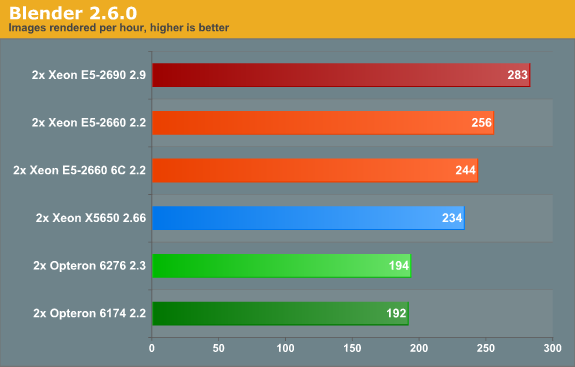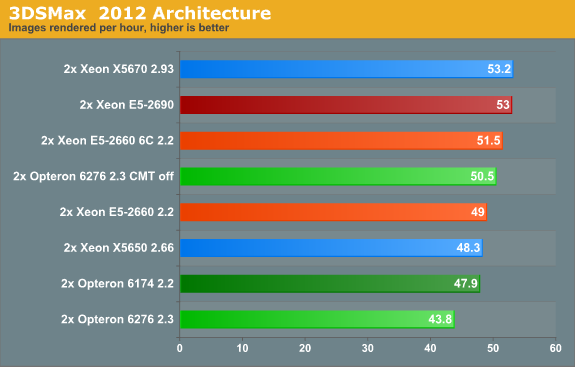The Xeon E5-2600: Dual Sandy Bridge for Servers
by Johan De Gelas on March 6, 2012 9:27 AM EST- Posted in
- IT Computing
- Virtualization
- Xeon
- Opteron
- Cloud Computing
Rendering: Blender 2.6.0
Blender is a very popular open source renderer with a large and active community. We tested the 64-bit Windows edition, using version 2.6.0a. If you like, you can perform this benchmark very easily too. We used the metallic robot, a scene with rather complex lighting (reflections) and raytracing. Furthermore to make the benchmark more repetitive, we changed the following parameters:
- The resolution was set to 2560x1600
- Antialiasing was set to 16
- We disabled compositing in post processing
- Tiles were set to 16x16 (X=16, Y=16)
- Threads was set to auto (one thread per CPU is set).
As we have explained, the current 24 and 32 core CPUs benefit from using a much larger number of tiles than we have previously used (64, 8x8). That is why we raised the number of tiles to 256 (16x16), though all CPUs perform better at this setting.
To make the results easier to read, we again converted the reported render time into images rendered per hour, so higher is better.

Blender is Xeon territory for sure, as Blender mostly runs in the L1 and L2 cache. Therefore a E5-2630 (2.3 GHz, 15 MB L3, $612) will probably perform about 4% faster than the six-core Xeon E5-2660 in this test. Our six-core Xeon E5-2660 is about 26% faster than the best Opteron. We estimate that the Xeon E5-2630 will offer more or less the same performance at an almost 30% lower pricepoint than the Opteron 6276. Whether you have a lot or little to spend, the Xeon E5 is your best bet for Blender.
Rendering Performance: 3DSMax 2012
As requested, we're reintroducing our 3DS Max benchmark. We used the "architecture" scene which is included in the SPEC APC 3DS Max test. As the Scanline renderer is limited to 16 threads, we're using the iray render engine, which is basically an self-configuring Mental Ray render engine.

We rendered at 720p (1280x720) resolution. We measured the time it takes to render 10 frames (from 20 to 29) with SSE enabled. We recorded the time and then calculated (3600 seconds * 10 frames / time recorded) how many frames a certain CPU configuration could render in one hour. All results are reported as rendered images per hour; higher is thus better. We used the 64-bit version of 3ds Max 2008 on 64-bit Windows 2008 R2 SP1.

Even with the advanced iray renderer, 3DS Max rendering reaches our scaling limits. The 32-thread Xeons do not come close to 100% CPU load (more like 90%) and in between the frames there are small periods of single threaded processing. Amdahl's law is most likely reason here. We suspect that highly clocked lower core count models can pass the 53 fps barrier we're seeing here.










81 Comments
View All Comments
think-ITB-live-OTB - Tuesday, March 6, 2012 - link
Can i ask you a question? do you at least get paid when you bend over for Intel?These are Server Chips - who cares about single-threaded application performance.. or Corporate IPOs. AMD has delivered far greater TCO/performance than Intel has for at least a Decade and running.
You want to praise a company like a Deity? ARM Holdings. nuff said. They can design a 35 dollar computer that can decode H.264 better than Intel can on SoCs that run 4x's the price. Currently have more Chips in more devices than in Intels entire history and Push Power envelopes far beyond anything Intel could ever muster.
Just you wait before the Storm ARM and its Licensees unleash as it will eventually take over ALL markets including the Server space (Calxeda much?). Oh and as for Apple. (an ARM Licensee itself... i can see them moving to in-house ARM designs pretty soon). 4-6-8 Core Cortex A15 (with A7 core for low power iPod/tablet sync) Macbook Airs anyone?
Intel is becoming the strongest of the Dinosaurs. But even the T-Rex fell eventually.
swizeus - Wednesday, March 7, 2012 - link
We have been using the Flemish/Dutch Web 2.0 website Nieuws.be as a benchmark for some time. 99% of the loads on the database are selects and about 5% of them are stored procedures.The database is loaded 104%. is it possible ?
JohanAnandtech - Wednesday, March 7, 2012 - link
Stored procedures can contain selects :-)fredisdead - Saturday, April 7, 2012 - link
From the 'article' .....'The Opteron might also have a role in the low end, price sensitive HPC market, where it still performs very well. It won't have much of chance in the high end clustered one as Intel has the faster and more power efficient PCIe interface'
Well, if that's the case, why exactly would AMD be scoring so many design wins with Interlagos. Including this one ...
http://www.pcmag.com/article2/0,2817,2394515,00.as...
http://www.eweek.com/c/a/IT-Infrastructure/Cray-Ti...
U think those guys at Cray were going for low performance ? In fact, seems like AMD has being rather cleaning up in the HPC market since the arrival of Interlagos. And the markets have picked up on it, AMD stock is thru the roof since the start of the year. Or just see how many Intel processors occupy the the top 10 supercomputers on the planet. Nuff said ...
InsaneScientist - Wednesday, March 7, 2012 - link
Johan, where in the specs where you have this line:Transistors (Billion) 2,26 2x 1,2 2x 904 1,17
I sure hope that 2x 904 (Billion) is a typo... otherwise AMD has some serious explaining to do. ;)
Should be 2x ,904 (I think? Would be 2x .904 for me, I assume you follow the same rules...)
iliev - Wednesday, March 7, 2012 - link
Page 5, Benchmark ConfigurationR2208GZ4GSSPP specs table... E5-2660 is 2.2Ghz, and not 2.9GHz
dodge776 - Wednesday, March 7, 2012 - link
Hi Johan,Always look forward to reading your server reviews at AT, but no SAPS benchmarks this time?
ppennisi - Wednesday, March 7, 2012 - link
For maximum VMware performance on Opteron Interlagos cpu under VMWARE it's better to disable C1E and enable, where available, HPC mode.I found myself on a fresh installation of ESXi 5.0 on Dell R715 that leaving C1E enable literally crippled vm performance.
boudini - Thursday, March 8, 2012 - link
I'm not sure I would recommend using iray as a reliable benchmark renderer in 3ds max. It is not a self configuring mental ray, but an unbiased renderer which behaves fairly differently to mental ray, and most other renderers such as vray, final render and brazil. It is comparible to maxwell and fryrender, but is very new compared to those two longer established unbiased render engines. It also attempts to use the gpu to add to its calculations as well - which could significantly skew results.Using mental ray or vray might well give you quite a different result, and besides I don't think iray is widely used in the industry.
omega4711 - Friday, March 9, 2012 - link
This. The results of iray are mostly dependent on the GPU. The lack of proper scaling certainly isn't due to Amdahl's law. Just use mentalray with small enough render buckets and you can easily satisfy 64+ threads.Also, due to the limitations of iray, it can (at this moment) only be used in about 1-3% of real world scenarios.
Please, for all the people that care about these benchmarks, use mentalray and/or vray.
Otherwise, it's a brilliant article.